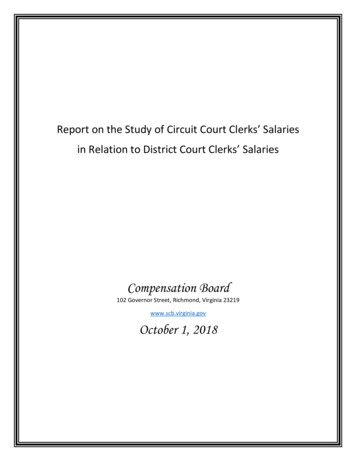
Transcription
Report on the Study of Circuit Court Clerks’ Salariesin Relation to District Court Clerks’ SalariesCompensation Board102 Governor Street, Richmond, Virginia 23219www.scb.virginia.govOctober 1, 2018
This page intentionally left blank
Table of ContentsIntroduction2Background of Circuit and District Court Compensation3Comparison of Circuit and District Court Compensation4Table 1: Classification and Pay Structure Comparison6Table 2: Position Distribution and Average Salaries7Table 3: Salary Increase History and Entry Level Salaries8Findings and Fiscal Impact of Addressing Disparities9Appendix A – Authority for the Study15Appendix B – Side-by-side Comparison of Court Compensation by Locality16Appendix C – Side-by-side Comparison – Non-Supplementing Localities48Page 1
IntroductionThe Compensation Board is pleased to present this report summarizing the review of circuitcourt clerks’ salaries in relation to district court clerks and deputy clerks staff salaries, pursuantto Chapter 2 of the 2018 Virginia Acts of Assembly. This report includes findings of thecomparison of the classification and pay plans, salary increase history, and average statesupported salaries and locality supplements of circuit court clerks and employees of the districtcourt system. As directed by the General Assembly, specific emphasis has been given tojurisdictions where locally funded supplements to salaries by a local governing body are notprovided for these positions.The Compensation Board would like to thank the Office of the Executive Secretary of theSupreme Court of Virginia for their participation and the technical assistance provided by staff.Questions or comments regarding this report should be directed to Robyn M. de Socio,Executive Secretary for the Compensation Board, at (804) 225-3439 or via email atrobyn.desocio@scb.virginia.gov, or to Charlotte W. Lee, Budget Manager for the CompensationBoard, at (804) 225-3366 or via email at charlotte.lee@scb.virginia.gov.Page 2
Background of Circuit and District Court CompensationThere are 120 elected circuit court clerks in Virginia. The Compensation Board compensateslocalities for salaries and benefits of 117 elected circuit court clerks and 1,083 deputy circuitcourt clerks and administrative positions. The Compensation Board spent 46.38 million inFY18 on compensation for salaries and benefits of state-supported circuit court clerks and theiremployees.The salary of the elected circuit court clerk is prescribed in the Appropriation Act (2018 GeneralAssembly, Special Session I, Chapter 2, Item 71, A.1) and is based on the population of thelocality served. There are 8 population brackets with a current salary range of 78,553 to 145,897. All circuit court clerks’ salaries may be supplemented locally.The salaries of staff positions in circuit court clerks’ offices are set based on the CompensationBoard’s approved pay bands and pay practices, which are similar to the Commonwealth’sDepartment of Human Resource Management salary structure, with each pay band comprisedof classifications with a single minimum and maximum salary range. Circuit court clerk staffposition classifications fall within 5 pay bands, with salaries that range from an administrativepay band with an entry level salary of 21,278 to a supervisory/management pay band with amaximum salary of 124,677 (the highest state paid salary within this range is 112,608);Compensation Board salary structure does not include a salary differential for Northern Virginialocalities. All circuit court clerks’ staff salaries may be supplemented locally, however, no staffpositon’s salary can exceed 90% of the salary of the circuit court clerk.Circuit court clerks are delegated the authority to use Compensation Board authorized budgetedfunds to affect the salaries of their employees within the compensation and pay plan and paypractices established by the Compensation Board, modeled after the pay plans and practicesused for state employees in Executive Branch agencies. Although the information on localsupplements is self-reported, most circuit courts report that they receive supplements to someor all of their Compensation Board funded positions. However, there are currently 17 offices thatreport no local supplementing of any Compensation Board funded circuit court clerk’s officepositions.The Office of the Executive Secretary provides centralized personnel support for 76 generaldistrict courts, 72 juvenile and domestic relations courts, and 44 combined courts (generaldistrict and juvenile and domestic relations courts combined in one court). Employees in thedistrict court system participate in an independent judicial personnel system and are classifiedas one of three general classifications: clerk of court, supervising deputy clerk, or deputy clerk.Within each of these classifications, there are multiple pay grades with entry-step salaries.The current statewide range of entry-step salaries for a clerk of court is between 36,915 and 60,325, depending on pay grade, with the maximum state paid salary in this classification of 120,121. The statewide range of entry-step salaries for a supervising deputy clerk is between 34,536 and 48,683, depending on pay grade, with the maximum state paid salary in thisclassification of 81,267. The statewide range of entry-step salaries for a deputy clerk isbetween 29,839 and 32,575, depending on pay grade, with the maximum state paid salary inthis classification of 60,379.Page 3
The district court salary and classification plan includes a salary differential of approximately22% for five Northern Virginia districts, applied to courts in seven localities (Alexandria,Arlington, Fairfax County, Fairfax City, Falls Church, Loudoun and Prince William). The currentNorthern Virginia salary range for a clerk of court is between 44,945 and 73,407 (maximumpaid 97,029), supervising deputy clerk between 41,996 and 59,246 (maximum paid 89,081), and deputy clerk between 36,292 and 39,640 (maximum paid 69,697).It is important to note that while the lowest grade for a newly hired deputy clerk is grade 7, withan entry-step salary of 29,839, or 36,292 in Northern Virginia, there currently remain 13positions statewide at a lower, grade 6, classification level with an entry-step salary of 28,427,or 34,571 in Northern Virginia. This classification level will soon be eliminated through attritionand/or targeted salary actions.There are currently only 8 of 76 general district courts, 7 of 72 juvenile and domestic relationscourts, and 4 of 44 combined courts that have state-funded salaries supplemented locally eitherby a fixed dollar amount or a fixed percentage above the state-funded salary.Comparison of Circuit and District Court CompensationThere are several notable differences between the Compensation Board’s classification and payplan and the district court systems’ salary and classification plan that make their comparisonchallenging.The Compensation Board’s classification and pay band structure was established to grouppositions with similar levels of responsibility and compensation, but each pay band includes avariety of classifications based on the varied responsibilities of their offices. For example, theadministrative pay band includes the classifications of microfilm technician, general office clerk,and clerk typist. The senior administrative pay band includes the classification of entry leveldeputy clerk, as well as cashier, bookkeeper, and senior clerk typist. Many employees of circuitcourt clerks are also classified separately based on their office’s or locality’s pay plan wheresome staff salaries are also supplemented locally.Compensation Board funded circuit court clerk budgeted funds were subject to previous budgetreductions, which reduced or eliminated non-personal services funds, and resulted in thereduction of salaries in some offices where non-personal services funding was insufficient tomeet across-the-board budget reduction requirements. As a result, the Compensation Boardfunded salary and classification of some positions may not accurately reflect their hierarchy andlevel of responsibility within their office. For example, a Compensation Board administrative payband, general office clerk position may be classified as a deputy clerk on their local pay planand receive a local salary supplement based on their locality’s pay plan or to make up for areduction in state salary funding. In some cases, the Compensation Board classification ofpositions was forced downward to keep them on the pay scale when the office had to reducestaff salaries.Additionally, there are currently 22 unfunded staff positions and another 114 positions withsalaries that are below the entry level salary of their classification’s pay band. The reducedsalaries (but not the unfunded positions) are reflected in the Compensation Board’s averagesalary used in this comparison. Some localities provide salary supplements to offset all or partPage 4
of the salaries affected by budget reductions. Again, this is reflected in the average local salaryof a Compensation Board funded position used in comparison with the average salary of anemployee of the District Court System.The pay grades within the District Court Salary and Classification Plan overlap the pay bands inthe Compensation Board’s state-funded Classification and Pay Plan. Although there is noadministrative (clerical) classification in the District Court System, the salary grades andresponsibilities of a deputy clerk in the District Court System fall within the salary range of thesenior administrative and professional pay bands of the Circuit Court staff pay plan (for low- tomid-level deputy clerks). The salary grades and responsibilities of a supervising deputy clerk inthe District Court System fall within the senior professional and supervisory/management paybands of the Circuit Court staff pay plan (for mid- to upper-level deputy clerks) and the salarygrades of a clerk in the District Court System fall within the salary range of thesupervisory/management pay bands of the Circuit Court staff pay plan (for upper-level/chiefdeputies), and into the pay ranges established for elected Circuit Court Clerks by the GeneralAssembly and specified in the Appropriation Act.While the pay bands in the Compensation Board’s Classification and Pay Plan are quite broadand extend far upward, as they were modeled after the pay band structure implemented forExecutive Branch agency state employees to encompass multiple classification levels andreplace multiple grade levels, almost all circuit court clerk employees’ state-funded salaries fallbelow the mid-points of their pay bands. Of 1,083 budgeted circuit court clerk employees, only8 positions (0.70%) have Compensation Board funded salaries above the mid-points of their paybands, while most have Compensation Board funded salaries that are clustered close to theentry-level of the pay band, such that the average salary within each pay band is significantlyless than the mid-point.Page 5
Table 1 – State Funded Classification and Pay StructureCircuit Court Classification and Pay Plan (excl ementElected Clerk ofCourtClassificationsMicrofilmTechnicianGeneral OfficeClerkClerk Typist IIDeputy Clerk ICashierBookkeeperSenior ClerkTypistAccountingTechnicianDeputy Clerk IIDeputy Clerk IIIAdministrativeAssistantDeputy Clerk IVAccountantAssistant ChiefDeputyChief DeputyClerk IComptrollerChief DeputyClerk IIChief DeputyClerk IIIISalary set byGA Per LocalityPopulationMinimumof BandDistrict Court Salary and Classification Plan (excl part-time staff)Positions MaximumTotalPaid Less CurrentMidpoint MaximumFundedthanStateof Bandof BandPositions Midpoint of SupportedPay 225124,677145,896721207175NonNonNOVANOVANOVANOVA MinimumMinimumMaximumMaximum Clerk(6) 7 - 929,83960,37936,29269,697SupervisingDeputyClerk10 - 1434,53681,26741,99689,081Clerk 6*State funded salaries for the elected Circuit Court Clerks are established in the Appropriation Act and are set based upon localitypopulation served, and do not reside within a pay band structurePage 6
Table 2 - Position Distribution and Average SalariesCircuit Court Clerk Classification and Pay Plan (excl unfunded pos)District Court Salary and Classification Plan (Incl NOVA; excl part-time staff)AverageAverageAveragePosition Percent of SupremeRolePay GradeTotalTotal sitionCountPercent ofPositionsAverageComp BdSalary1Administrative595%21,78232,7282Sr. %32,88040,8427Sr. nt726%55,91271,138Elected Clerk of puty Clerk(6) 7 - 91,17576%34,27235,204SupervisingDeputy Clerk10 - 1417411%45,42747,281Clerk of *There are 22 unfunded positions in Circuit Court Clerks’ offices that are excluded from the position count and calculated averagesalaries.**Average total salary amounts include the state funded salary plus the local salary supplement.*** District Court Clerk of Court total includes two part-time FTE (Franklin County GDC and Pittsylvania County GDC)Page 7
Table 3: State Salary Increase History & Entry Level SalariesCIRCUIT COURT CLASSIFICATION AND PAY PLANPAY BANDFiscalYearDateFY2008 12/1/2007FY2009FY2010FY20111247DISTRICT COURT SYSTEM SALARY/CLASS PLAN (excl NOVA)8SalarySr.Supervisory/Admin Sr. Admin ProfessionalIncreaseProfessional 1/25/200711/25/2008(4-5)/(6) 7-9Salary Increase Deputy 45,3803% bonus5% Incr to offset7/10/20115% VRScontribution12/10/20123% bonus2% plus 65/year7/25/2013of service10-1410-15Supervisory Clerk ofDeputy Clerk 014 8/1/2013PAY GRADESFY2015FY2016 152.00%21,27825,42230,39336,31247,2147/10/20172% plus 65/yearof service; add'l2% for DeputyClerks (Grades 68)FY20178/1/2017FY20189/10/20173.00% 2.8M TotalIncreases*State entry-level salaries exclude local salary supplements**FY 2018 salary increase cost for district court clerks totaled to the appropriated amount of 3.5 million, including salary and associatedfringe benefit costsPage 8
Findings and Fiscal Impact of Addressing DisparitiesThere is no classification in the district court salary and classification systemcomparable to the elected circuit court clerk.For salary comparison, clerks within the district court system more closely resemble thesupervisory/management pay band within the Compensation Board’s classification and pay planbased on their average salary. Similar to other employees in the district court system, thesepositions are advertised through the Human Resources department of the Supreme Court’sOffice of the Executive Secretary and they are appointed and serve at the pleasure of the chiefjudge. As elected constitutional officers, the salaries of circuit court clerks are statutorilyestablished by the General Assembly and prescribed in the appropriation act.While the responsibilities of a court clerk in the district court system are more narrowly defined,circuit court clerks are elected constitutional officers and provide a wide-ranging array of otherservices that include: land records management, probate and fiduciary duties, issuing ofmarriage licenses, concealed weapons permits and processing of notary public commissions,custodian and official record keeper of election ballots, and maintaining a public law library.Elected circuit court clerks are responsible for making all personnel decisions for staffing in theiroffices, within their Compensation Board authorized budget and within the parametersestablished in Compensation Board approved pay practices, and their employees serve at theirwill.The district court salary and classification plan has phased out the pay grades mostcomparable to the Compensation Board’s administrative pay band.Prior to FY16, the district court pay plan included three pay grades below the current, entrylevel, grade 7 deputy clerk classification, with an entry level salary that was within 3% of theentry level salary of the Compensation Board’s administrative pay band. However, two of thesepay grades (grades 4 and 5) were eliminated. In addition, Grade 6, which is made up of only 13positions statewide, will soon be eliminated. Newly hired deputies are provided a salary amountno less than the entry step of a Grade 7, which is currently 29,839 (or 36,292 in NorthernVirginia). The elimination of these lower classifications was based on increased duties andresponsibilities, as well as phasing out of employees in these lowest pay grades over timethrough attrition, changing job descriptions and targeted salary increases.The current entry level salary of a Compensation Board funded administrative (clerical) position,which is classified as an administrative role or pay band 1, is 21,278. However, due tounrestored budget reductions, the average Compensation Board funded salary of anadministrative position just barely hovers above the entry level salary, at 21,782. There arecurrently 59 Compensation Board funded circuit court employees in the administrative pay bandof the Compensation Board’s Classification and Pay Plan. The entry level salary of the senioradministrative pay band (containing entry level deputy clerks) is 25,422, which is 4,144 or19.48% more than the entry-level salary of an administrative position. The cost to eliminate theadministrative pay band and bring these salaries up to the current salary level of the senioradministrative pay band (entry-level deputy clerk) would be 241,960.Page 9
The Compensation Board’s entry level salary for a deputy circuit court clerk issignificantly lower than the state-funded entry level deputy clerk salary in the DistrictCourt System.The current entry level salary of a Compensation Board funded deputy clerk, which is classifiedas a senior administrative role or pay band 2, is 25,422 as compared to the entry level salaryof 29,839 of a deputy clerk, pay grade 7, in the District Court System, a difference of 4,417 or17.37%.Prior to the increases to district court staff salaries implemented in September 2017, thatdistributed 3.5 million ( 2.8 million in salary dollars) primarily to positions that were below thenewly established grade minimums and increased the entry-level salary of a district court deputyclerk by 7%, the salary of an entry-level deputy clerk in the district court plan had not been morethan 4.5% above the Compensation Board funded entry-level salary of a deputy clerk of thecircuit court.There are currently 365 Compensation Board funded circuit court employees in the senioradministrative pay band (deputy circuit court clerks) of the Compensation Board’s Classificationand Pay Plan. Their average Compensation Board funded salary is currently 26,095, adifference of 3,744 or 14.35% below the entry-level salary of 29,839 for a state-funded DistrictCourt System deputy clerk, with 338 positions (93%) having individual Compensation Boardfunded salaries below this entry-level.When local salary supplements are considered, the average total salary of a CompensationBoard funded position in the senior administrative pay band is 35,158, which more closelyaligns with the salaries of deputy clerks in the district courts. However, a total of 149 (41%) ofthe 365 employees in this pay band either do not receive a local supplement, or receive a localsupplement but still have salaries below 29,839, the entry-level salary of a deputy district courtclerk. Local salary supplements for deputy circuit court clerks in Northern Virginia, where theCompensation Board is not funded to provide for a salary differential, tend to be higher, anddrive up the average statewide total salary.The cost to increase the Compensation Board salaries of 338 deputy circuit court clerk positionshaving state salaries below the entry-level salary of 29,839 for a deputy clerk in the DistrictCourt System, plus 5 deputy circuit court clerk positions in higher pay bands that also have statesalaries below 29,839, to get to that minimum, would be 1,543,347.Often recommendations to increase the base salaries of Compensation Board fundedemployees in any constitutional office have been met with reservations due to a variety ofreasons, including the impact of local salary supplements on base salary levels funded by theCompensation Board. However, it is important to note that there is no requirement thatlocalities continue to fund local supplements for any given position at any time. While it is theCommonwealth’s obligation to fund the salaries of state-supported positions in circuit courtclerks’ offices, most localities have provided local supplements to the salaries of CompensationBoard funded deputy circuit court clerk positions in response to a series of budget reductionsover the past decade that have required elected Clerks to cut the state-funded salaries of theirstaff in order to meet mandated state general fund reductions, and then to further compensatefor several years when no state-funded salary increases were provided to state-supported localemployees. Localities are known to reduce supplements when the local fiscal climate dictates,and there is no guarantee that a supplement provided to one deputy clerk will be continued ifPage 10
that individual leaves and a new deputy is hired, nor is there any guarantee that a new deputyclerk position allocated to an office due to workload increases would receive a supplement justbecause one or more deputies in that office already receive a supplement. It is also importantto note that when the Commonwealth is able to fund salary increases to these constitutionalofficer employees, localities often absorb these increases to offset funds they have provided upfront to allow salaries to be increased at the same time as increases for locality employees, withknowledge that the state-funded increase is forthcoming, or to offset local supplements thatwere provided to make up for a cut to state funding. Overall compensation for the employeemay not actually increase, but state funding moves closer to levels that are appropriate tosupport these offices.If choosing to consider local supplements as a component of total salaries, the cost to provide aCompensation Board funded increase in the total salary, to achieve the entry-level of 29,839when including the existing local supplement, would be 532,622 for the 149 deputy circuit courtclerk positions in the senior administrative pay band and 5 deputy circuit court clerk positions inhigher pay bands with total salaries below this level. While this may be considered a lower-costalternative to the Commonwealth, as noted above, there is no guarantee that the localsupplement would be maintained, and would likely result in individual deputy clerks’ totalsalaries falling below the “new” entry-level as individual supplements are reduced or eliminated,maintaining ongoing parity problems. Also, if parity is to be achieved, new Compensation Boardfunded deputy circuit court clerk positions should be established at a state-funded entry-levelsalary that matches the salary provided for a deputy clerk in the district courts, but parityproblems could continue if an existing position in the same office were to lose a localsupplement. Ultimately, what is most appropriate is that the Commonwealth provides acomparable state-funded salary structure for both court systems, leaving local supplements toprovide aid in areas where cost-of-living dictates (such as Northern Virginia, where the districtcourt system provides a salary differential but the circuit court system through theCompensation Board does not, or in other areas of the state where localities providesupplements in both court systems to maintain competitive salary offerings), and defrayingsome of the state costs that have been pushed to localities in recent years in many formsbeyond just compensating for lower salaries.Alternative Considerations for Positions in the Administrative pay bandIn the Compensation Board pay plan, there is currently a difference of 19.48% between theentry-level salary of the administrative (clerical) pay band, at 21,278, and the entry-level salaryof the senior administrative (entry-level deputy clerk) pay band, at 25,422. In the District CourtSystem, comparable positions were upgraded to the deputy salary level with lower classificationlevels eliminated, and proposed costs to do likewise for these positions in circuit court clerks’offices were cited earlier in this report. In the absence of the promotion of these positions to adeputy clerk level (from the administrative pay band to the senior administrative pay band), itwould still be necessary to provide a comparable increase along with any salary parity action toaddress state-funded salaries of deputies in circuit court clerks An increase to theCompensation Board funded entry-level salary of the administrative pay band by the same17.37% difference as currently exists between circuit court and district court entry-level deputysalaries would result in an increase to the entry-level salary of the administrative pay band from 21,278 to 24,975, and would result in a cost of 215,943 to bring 53 of the 59 positions in thepay band up to the higher entry-level salary.Page 11
The average state-supported salaries of circuit court clerk employees overall is 15.0%less than the average state-supported salaries of employees in the district court salaryand pay plan, when Northern Virginia courts receiving the salary differential areexcluded. However, this variance is lower than for entry-level deputies, as local salarysupplements even out salaries in the higher classification levels.When examining all salaries of circuit court clerk employees at all levels in comparison with allsalaries of district court employees, excluding Northern Virginia (where district court employeesalaries include a differential, and circuit court clerk employee salaries tend to be supplementedlocally at higher levels), there are still overall differences between the two courts in averagestate-funded salaries. While the greatest differences exist with entry-level deputies, higher leveldeputy salaries and supervisory level deputy salaries also vary between the two systems at thestate-funded level. The average state supported salary of a district court employee is 37,566as compared with the average salary of 32,654 in a Compensation Board supported circuitcourt clerk staff position, a difference of 4,912 or 15.0%. However, when local supplements areincluded, the average total salary of a district court employee is 38,038 as compared with theaverage total salary of 38,127 in a circuit court clerk staff position, a difference of ( 89) or(0.23%).The average state-supported salary of a circuit court clerk employee in a locality thatdoes not provide salary supplements is 32,232, or 16.52% below the average statewidesalary of an employee in the district court salary and pay plan, when Northern Virginiacourts receiving a salary differential are excluded.There are currently 17 circuit court clerks’ offices with a total of 81 staff positions that report thattheir locality provides no local salary supplements to their Compensation Board fundedemployee positions. While this represents only 14% of offices, it represents over 22% ofadministrative and deputy positions. The average statewide salary of a Compensation Boardsupported circuit court clerk staff position in a locality that does not provide salary supplementsto staff is 32,232, a difference of 5,324 or 16.52% less than the average statewide salary of adistrict court employee of 37,566 (excluding salaries of district court employees in NorthernVirginia). The average statewide salary of a Compensation Board funded circuit court clerk staffposition in these non-supplementing localities is 4,354 less, or 13.51% less, than the averagesalary of a district court employee of 36,586 in these same districts.While many localities do supplement the Compensation Board funded salaries of deputies andother employees in circuit court clerks’ offices, they supplement these offices significantly lessthan other employees in other constitutional offices. Of the 103 localities that supplement atleast one salary in a circuit court clerk’s office, the overall supplement amounts range from 1%to 282% (an outlier) above the state funded amount, with 4 localities supplementing 100% ormore and 57 offices supplementing 10% or less. Overall, the average of all supplements is 21%and the median is 11%. As the Compensation Board does not fund a salary differential foroffices or employees in Northern Virginia, these localities tend to supplement by a greaterdegree, with an average supplement amount of 70% above the Compensation Board salaryamount; however one Northern Virginia locality, the City of Alexandria, supplements only 11%.Finally, while one of the barriers to increasing state-funded base salary levels for employees inconstitutional offices is often that localities are already funding supplemental amounts toincrease employees’ overall salaries, these supplements vary and change over time, and are inPage 12
no way required. Seventeen localities choose not to supplement their
Arlington, Fairfax County, Fairfax City, Falls Church, Loudoun and Prince William). The current Northern Virginia salary range for a clerk of court is between 44,945 and 73,407 (maximum paid 97,029), supervising deputy clerk between 41,996 and 59,246 (maximum paid 89,081), and deputy clerk between 36,292 and 39,640 (maximum paid 69,697).










